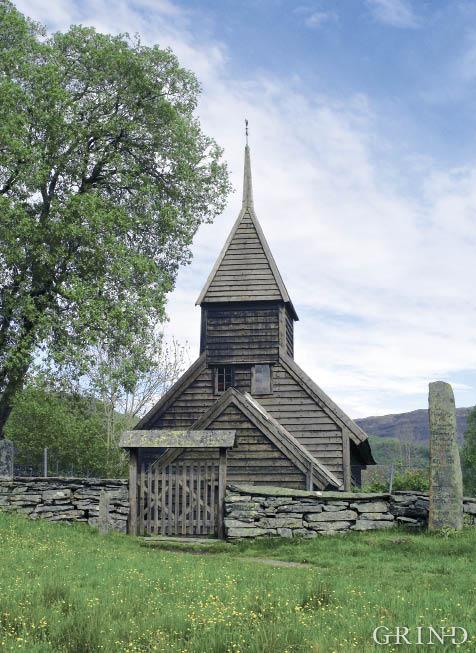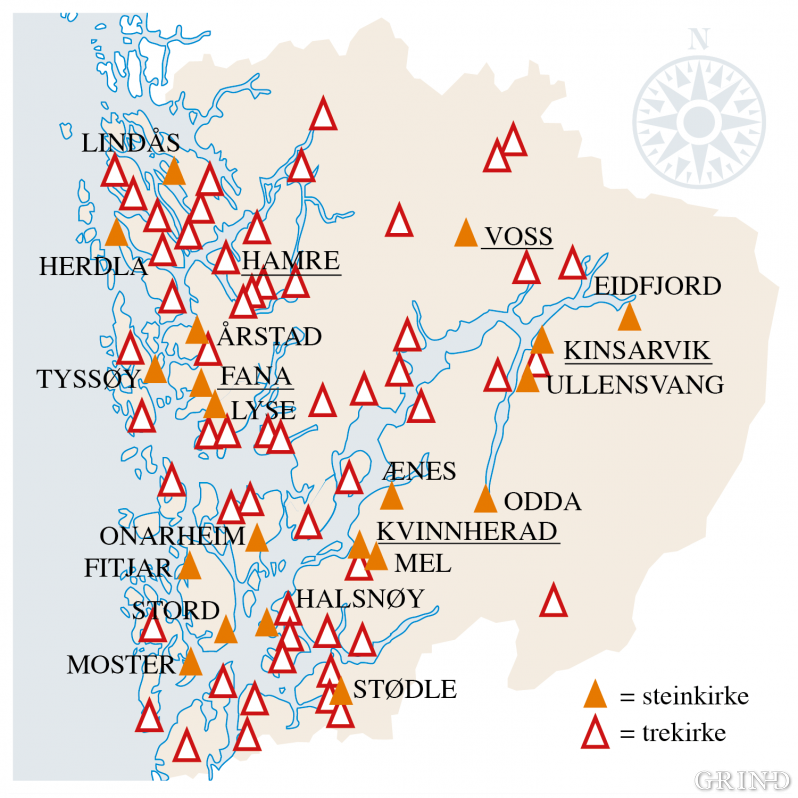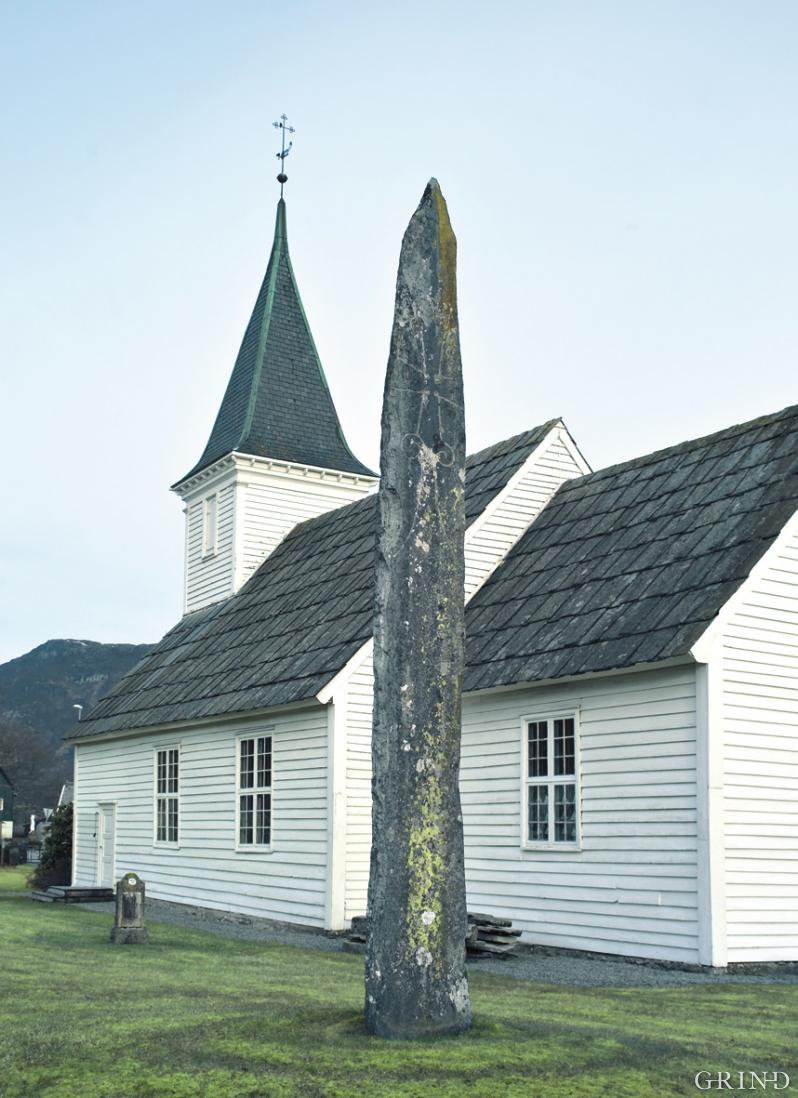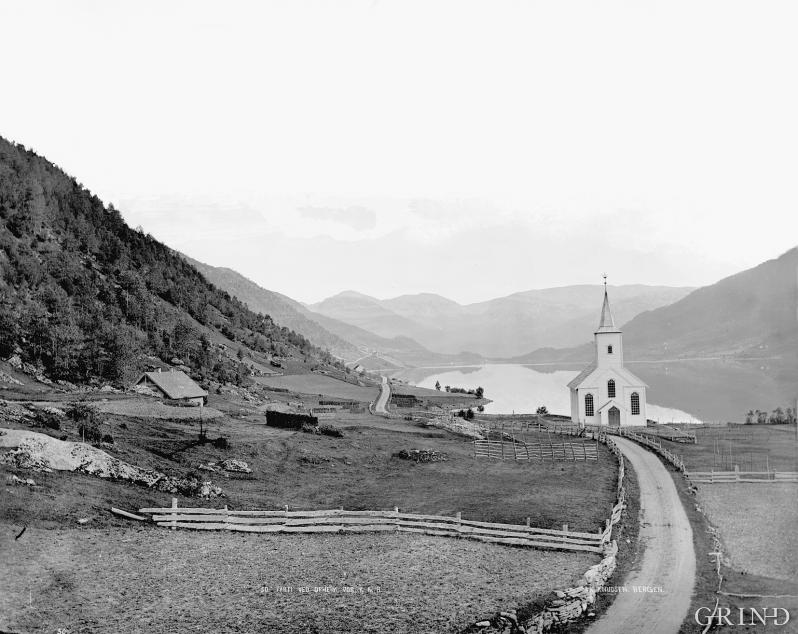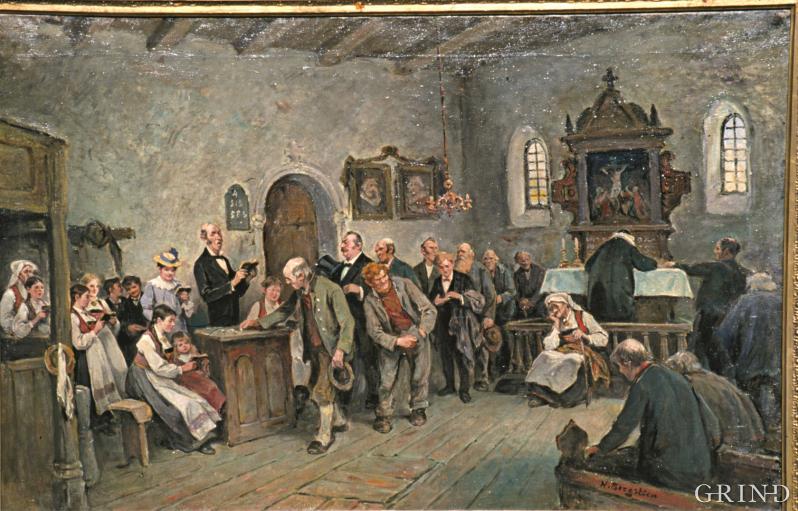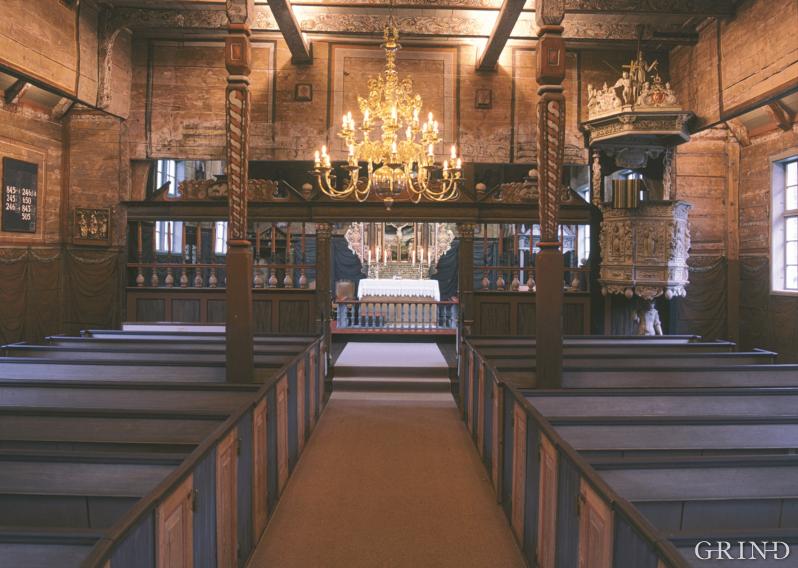Published: 19.05.2009 | Author: Hans Emil Lidén
The old church at Strandebarm which Hans E.Kinck remembers from his childhood, was of the same type as the church at Holdhus. (unknown, owner: Riksantikvaren (ark nr. A274).
THE MOVING FORCE IN LOCAL SOCIETY
“I recall the church’s exterior, the black tar-clad timber walls with the black pan tiles; I remember it made a gloomy impression in the midst of the luxuriant greenery and up against Bergstonaas steep cliffs --- but of the inside I recall little. The pew frames were certainly high; I saw the painted wooden sculptures, and it seemed to me that there was a lot of white and light blue. But the interior space was incredibly filled with the play of light. For there were old tiny, blue and green and brown window panes set in lead. The light from above seeped secretly down on to the church pews on to people clad in blue and on to old, freshly shaved faces which were framed in a wreath of white hair and fisherman’s beard beneath the chin and on the throat. The sight of them struck me in the church. The blue and white once again.”
This is how the poet Hans E.Kinck recalls the old church at Strandebarm which was pulled down in 1976. It was not the only one. In the course of the second half of the 19th century 62 new churches were opened. Most of these replaced older churches.
It is not surprising that the towering, white painted 19th century wooden church is a characteristic feature of today’s landscape, whether it lies out on one of the islands or up the fjords. One hundred and fifty years ago the picture was completely different. Then it was the modest, tar clad timber churches which Hans E.Kinck describes, which were the norm. And long before that time in the Middle Ages, it was the stately stave churches which dominated, with the odd white lime-washed stone church between.
Only a few of the old wooden churches still exist. Up in the mountain hamlet of Røldal lies the county’s only remaining stave church. Holdhus Church in Hålandsdalen and Hamre Church on Osterøy are the only reasonably untouched timber churches in the county. In addition there are a few reconstructed and extended timber churches from the 17th and 18th centuries, but they are usually painted white and are uncannily similar to the churches from the 19th century.
The medieval stone churches are better preserved. Most of them are to be found in the southern part of the county, and inland in the Hardanger interior.
The church sites
The church building, whether it is new or old, usually lies on an old church site, and the location of these church sites and what sort of churches are built there can tell us much about social conditions in the county over time. The church sites were the social centres of gravity in a local context. Some were clearly linked to major farming properties and show that an aristocratic environment can have dominated a village whilst others, simply because of their location, show that they must have been built by a farming society consisting of equals. Here the siting of church has, to a greater extent, been conditioned by the fact that those who built the church have been agreed on a site at a roughly equal distance from the farms which belong to the church. The building material also says something about village society. In some places people felt they could afford to build in stone whilst in other places people kept to wood as a building material. In this way the church building itself provides us with an understanding of the social structures in the county at different times in history.
Now in fact the main features of the economic and social structure of the county had been delineated before the first churches were built. As far back as prehistoric times the division of the county into four parts - based as it largely is on natural features - must have taken place. By way of archaeological finds and early stories from the sagas, we get an impression of an aristocratic environment in Sunnhordland, perhaps a more equal society of well-to-do farmers in Hardanger and Voss, whilst conditions in the heath areas and the villages up the fjords in Nordhordland seem to have been poorer.
The stone churches
The building of churches in the Middle Ages confirms this picture in many ways. Altogether in Hordaland of the Middle Ages there were 62 wooden churches and 20 stone churches (not including the churches in Bergen). The very first church we hear about is the church which, according to the Saga, King Olav Tryggvason allowed to be built at Moster in Sunnhordland in 996 AD. It must have been a forerunner to the existing stone church which dates from the 12th century. Moster Church was clearly built on an ancient gathering place which was situated centrally in the route. Councils were held there, and the place was the seat of an important family with links back to the aristocracy of the chiefs in the Viking times.
Moster Church as it stands today belongs amongst the oldest stone churches in the county. The other early stone churches were, for the most part, precisely in Sunnhordland. Besides Moster there are also the royal estate church at Fitjar which has now been pulled down, the church at Stødle in Etne which was Erling Skakke’s and Kong Magnus Erlingsson’s ancestral farm and the demolished church at Onarheim in Tysnes which also had clear associations with an important family (Sigurd of Onarheim is mentioned in Håkon Håkonsson’s Saga). The royal estate church at Alreksted (Årstad) in Bergen which has disappeared also belongs to this group. All these churches were either built by the king himself or of important nobles in his immediate proximity. It looks as if it was only in that group that they were able to erect stone churches in the 12th century.
The stone church which is closest in time to the Sunnhordland group is the church in Kinsarvik. It must have been built around the year 1200 apart from the chancel which was built some time later. But here we are faced with a much larger building than the early churches in Sunnhordland. Who can have been able to erect such a big stone church precisely here? The question cannot be answered with certainty, but some elements of explanation can be indicated. Kinsarvik has an ideal location as a meeting place for folk who came from the east over the Hardanger plateau (Hardangervidda), and folk coming from the west, from the hamlets in the fjords and from the coastal areas. Just beside the church there are clear traces of a Middle Ages marketplace in the form of an area of black earth which has not yet been properly investigated by the archaeologists. It is feasible that this market place which at times must have gathered together many folk, can have given the occasion and the necessary economic basis for building the church.
The fjordung churches
In addition Kinsarvik was, as far as we can judge, one of the county’s “fjordung” churches. This term goes back to the Gulating laws (local Parliament for Western Norway) regulations regarding churches in the counties of western Norway. According to these regulations, which in their oldest form go back to the 11th century, there was to be one main church in each county. The law also mentions “fjordung” churches which are churches which will serve a fourth part of the county.
In Hordaland County it is difficult to point to a first main church for the whole county. Moster Church has been proposed, but it is not at all centrally situated. On the other hand it is reasonable that the churches at Kvinnherad, Kinsarvik, Voss and Hamre have been “fjordung” churches for Sunnhordland, Hardanger, Voss and Nordhordland respectively. Sources from the High Middle Ages confirm that these churches enjoyed a special rank amongst the churches in the county. They are usually called principal churches and the ministers are called principal ministers. In the 13th century big stone churches were built at Kvinnherad and at Vossevangen whilst the church at Hamre remained a wooden church throughout the Middle Ages. Kinsarvik is the oldest of the big stone churches, and it is probable that it is precisely its position within the church hierarchy that has been a contributory reason for it having been built of stone.
Estate chapels and royal chapels
Apart from the “fjordung” churches which by way of their size and special form are in a class of their own, a series of stone churches was built in the county - first and foremost in Sunnhordland and Hardanger. In terms of importance and size these churches vary from estate chapels (Mel in Rosendal) to parish churches with several ministers (Ullensvang). Some of them (Ænes, Odda and Lindås) can have been built as private churches, may also have functioned as parish churches. Three churches (Eidfjord, Stord and Herdla) were given a special long church form which was derived from the monastic churches.
In addition to these churches a church was built in Fana which corresponds in terms of size and form to the “fjordung” churches. The earliest history of this church is extremely unclear. It was reconstructed in the 1220s in connection with a hospital being linked to it. Later it became one of king Håkon V. Magnusson’s 13 royal chapels.
Churches along the seaways
Besides the Church of the Apostles in Bergen two other stone churches in the county belonged to King Håkon V’s chapel arrangements. They were the tiny Ludvig’s Chapel on Tissøy, south west of Bergen and Herdla Church in Nordhordland (both have disappeared). These churches lay along the ship lanes and there is a lot to indicate that they were built especially to meet the religious needs of the seafarers. They must be regarded as being churches outside the regular system of parishes. The history of Herdla Church goes back to the 12th century when Munkeliv Monastery in Bergen owned it. It is possible that the monastery was obliged by King Eystein to build and run it and a corresponding “seaman’s church” on Kvitsøy in Hordaland county in return for the king giving property. According to the saga King Eystein “established” the Munkeliv monastery, and the saga praises him because he erected churches and hostels for travellers. As a royal chapel Herdla Church must again have come under the control of the king. The church was converted to being a long church around 1300, and from then on must have served as an ordinary parish church.
The churches of the middle ages and conditions for the farm properties
If we examine the map on page 53 we shall see that it is clear that the majority of the churches from the Middle Ages were situated in coastal regions. Of course the natural explanation for this is that the inland parts of the county are mainly occupied by mountain areas. On the basis of the density of churches it is reasonable to assume that the majority of the population also lived in coastal areas. However it is not self-evident. The relationship in size of the coastal population and the population in the inner fjords and valleys may have been more even than the density of churches suggest. It is noticeable how few stone churches have been built in coastal districts in the 13th century. If we ignore the royal chapels there is one church in Sunnhordland (Stord) and one in Nordhordland (Lindås). In the same period four stone churches were built in the central and inner fjord settlements in Hardanger (Ænes, Odda, Ullensvang and Eidfjord) as well as the two large “fjordung” churches in Kvinnherad and Voss.
The construction of stone churches presupposes an economic foundation which again has a certain relationship with the size of the population. It could be that the topography itself in the fjord settlements and in Voss led the church parishes to be bigger than out on the coast. On the other hand the social structure of the population must have played a part. At the end of the Middle Ages Sunnhordland and Hardanger were almost teeming with family farms for ancient noble families. In Sunnhordland alone there were about 30 such farms whilst in Nordhordland there were only a few. It is interesting to compare this with the analyses which have been done on conditions for the landed properties. These show that the percentage of land owned by farmers and nobility was much higher in the inner and central districts of the county than in the areas on the coast where the king and the central church institutions (the episcopal seat, the chapter house, the monastery and the royal chapels) owned most of the land. Historians have indicated that this situation may be due to the fact that the local “big men” in Viking times, the ruling aristocracy lived on the coast, and their properties were, to a large extent, confiscated by the king in a National Council to be later handed over to the episopal seats, monasteries and royal chapels as these institutions developed. The central and inner parts of the county were less affected by this process.
The image which this picture conjures up is that on the coast in the Middle Ages there was a population of farmers and fishermen who, to a large extent, were tenants of the Crown and the central church authorities, whilst the population in the central and inner parts of the county were either wholly or partly independent owner-occupiers, or were tenants under local powerful men. Such a society would have more interest in using its financial surpluses on local church buildings, than would the population on the coast who scarcely received bigger contributions from the central powers. The result seems to have been many, humble churches out on the coast; fewer and more resplendent churches in the fjords and the valley settlements.
The wooden churches
The central theme of this article has been the stone churches. But what of the wooden churches? Could they have supplemented - perhaps corrected – the outline that we have attempted to draw?
The question is difficult to answer because all the wooden churches from the Middle Ages -with the exception of all but one - have disappeared. Something indicates however that at least in one settlement folk went in for building a wooden church whose reputation could measure up to other settlements’ stone churches. In Ulvik there existed a stave church until 1710 whose choir portal was luckily preserved. Later it came to Bergen Museum, and is reckoned today to be our best preserved stave church portal apart from the Urnes Church portal in Sogn. From other churches e.g. Granvin, we know of furniture and fittings from the Middle Ages, which indicate that the church, at least in terms of contents, could measure up to the stone churches.
The monasteries
Besides the churches there was a series of monasteries in Hordaland in the Middle Ages. Five of them lay close to, or in Bergen, whilst two – Lyse monastery in OS and Halsnøy monastery in Sunnhordland – had no connection to the town. Nor do these monasteries belong to the oldest group of Norwegian monasteries which were founded in physical proximity of the episcopal seat - clearly in order to build up an ecclesiastical environment around the bishop in early times. Lyse was founded in 1146, whilst Halsnøy appears to have been founded in 1163.
Both of these monasteries belong to monastic orders which were required to live withdrawn from the world. Lyse was a Cistercian monastery and Halsnøy was an Augustinian one. However as two major property owners they came to have much to say about the development of Hordaland. About one fifth of Lyse Monastery’s landed property lay in Os Municipality. In addition the monastery owned the Opedal farm in Ullensvang in Hardanger. The rest of the property consisted mainly of smaller bits of farms spread out over larger parts of western Norway. These probably represented mainly gifts from individual people to the monastery over a long period of time, whilst the farms in Os and Ullensvang can originate from the time of its foundation and represents a gift from the king or the bishop which secured the monastery’s economic existence.
Halsnøy monastery’s concentration of property in Etne and Fjelberg must have a corresponding significance. In Etne the monastery owned, amongst other things, the Gjerde farm which was the seat of Erlend, the great-great grandfather of Erling Skakke who founded Halsnøy Monastery.
Church building and population growth
Was the population of Hordaland constant during the Middle Ages? The building of the relatively large stone churches in central and inner districts (churches which must have replaced earlier churches) can point to a certain increase in population in the 13th century. It is in this context that the early stone churches in Sunnhordland remained untouched by rebuilding and reconstruction. Perhaps they built more churches in a settlement rather than extending the existing ones. This, at least, seems to have been the case in Etne where there were two stave churches in the 14th century in addition to the stone church at Stødle.
The period after the middle ages
Some time in the 14th century church construction in Hordaland halted as far as we can understand. It was only in the 17th and 18th centuries that they began to build new churches again. Then many stave churches were replaced by timber churches built with round logs. The reasons for this was not only that the stave churches were old and dilapidated. The new churches were built bigger and they were better adapted to the Lutheran form of divine service. Where the preacher played a pivotal role. The new churches were also one of the visible signs of an economic period of prosperity which developed in the 17th century. Their heyday lasted for about 200 years. Then came a new period of social and economic upheaval – a period which marks the final farewell to the old farming society in Hordaland. The shift expressed itself in both material and immaterial terms. Two fundamental factors in the development were an increasing population and a switch from the subsistence economy to the monetary economy. But the introduction of municipal government and the growth of a low church, pietistic movement linked to the name of the theologian Gisle Johnson also played an important role, not least when it came to the building of new churches.
One of the first things that the new municipal councils did was to purchase the churches from the private owners who had held them since the king had sold them at the beginning of the 18th century in order to get money for the treasury. In this way the congregations were ensured authority over the churches. This led to a gradual “democratisation” of the churches as the senior public servants’ and the church owner’s private pews which were such a prominent feature of the old churches were thrown out together with much else of the contents of the old churches.
The stave churches fall
In a great many cases it was not only the interiors that were destroyed, it was the whole church building which was pulled down. The direct cause of this was the law of 1851 which laid down that the parish churches should accommodate a certain percentage of the parish’s population. Most of the old churches were thus too small, and had to be replaced by bigger buildings.
The Ministry of Religious Affairs had standard plans drawn up for the new churches - plans which were often varied or simplified by local builders. The result was that the new churches took on a fairly uniform appearance - at least at first glance. They often appeared to us as cold and dreary with their high-ceilinged rooms, large areas of window and fairly bleak interiors. However the details bear witness to carpentry and joinery work of the highest quality.
An example of an early model church in Hordaland is Vikøy church in Hardanger built in 1839 to the plans of the palace architect Hans D.F.Linstow. Ølve church in Kvinnherad also had standard plans by Linstow as a point of departure. In addition, interesting examples of 19th century church architecture in Hordaland are the churches at Sveio and Samnanger which were both designed by the self-taught architect Andreas Grønning from Bergen who was qualified as a theologian. Os church south of Bergen, built in 1870 by the well known builder Ole Vangberg, and Utne church in Hardanger built in 1894 from plans of the architect Peter Blix are typical examples of west Norwegian church buildings from a little later in the 19th century.
The old cultural landscape changed drastically during the 19th century. The white painted wooden church had become the dominant feature of the landscape of our times.
- Bendixen, B. E. (1904-1913) Kirkerne i Søndre Bergenhus amt: bygninger og inventarium. Bergen, Grieg.
- Lange, C. C. A. (1856) De norske Klostres Historie i Middelalderen. 2. utg. Christiania, Chr. Tønsbergs Forlag.
- Foreningen til norske fortidsminnesmerkers bevaring, Årbok (1987). Oslo, Foreningen, s. 6-238.


